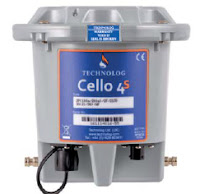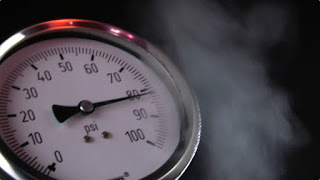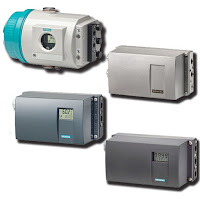"We hold these truths to be self-evident, that all men are created equal, that they are endowed by their Creator with certain unalienable Rights, that among these are Life, Liberty and the pursuit of Happiness. — That to secure these rights, Governments are instituted among Men, deriving their just powers from the consent of the governed, — That whenever any Form of Government becomes destructive of these ends, it is the Right of the People to alter or to abolish it, and to institute new Government, laying its foundation on such principles and organizing its powers in such form, as to them shall seem most likely to effect their Safety and Happiness."
THOMAS JEFFERSON, Declaration of Independence
Educational information on process control, industrial instrumentation, valves, valve automation and control valves. For additional information visit IvesEquipment.com or call 877-768-1600
Refinery Gas Analyses Using Compact Gas Chromatographs and Gas Detectors
The analysis of trace permanent gases has many different fields of application in the petrochemical industry. One of the most important is for controlling the manufacturing process and the product quality. For example, some contaminants as carbon monoxide and carbon dioxide tend to deteriorate the catalysts in the propylene and ethylene polymer grade production.
An instrument for monitoring trace impurities is then required. Many different GC techniques are available on the market. Most of the techniques use a combination of TCD, FID and methanizer for the trace analysis of H2-O2-N2-CH4-CO-CO2 in propylene and ethylene. More precisely, an FID and a methanizer are used to trace CH4-CO and CO2. A TCD with Hydrogen or Helium carrier gas is used to trace O2-N2 detection. Finally, a second TCD with Argon or Nitrogen carrier gas must be added to trace H2 detection. These solutions require complex GC solutions with multiple detectors and multiple gas sources for carrier, fuel and air. On top of that, an FPD must be added in some cases when the trace analysis of H2S is required.
Read the application note below for more information. Contact Ives Equipment at (877) 768-1600 or visit http://www.ivesequipment.com for a consultation.
An instrument for monitoring trace impurities is then required. Many different GC techniques are available on the market. Most of the techniques use a combination of TCD, FID and methanizer for the trace analysis of H2-O2-N2-CH4-CO-CO2 in propylene and ethylene. More precisely, an FID and a methanizer are used to trace CH4-CO and CO2. A TCD with Hydrogen or Helium carrier gas is used to trace O2-N2 detection. Finally, a second TCD with Argon or Nitrogen carrier gas must be added to trace H2 detection. These solutions require complex GC solutions with multiple detectors and multiple gas sources for carrier, fuel and air. On top of that, an FPD must be added in some cases when the trace analysis of H2S is required.
Read the application note below for more information. Contact Ives Equipment at (877) 768-1600 or visit http://www.ivesequipment.com for a consultation.
Labels:
Delaware,
Gas Chromatograph,
gas detection,
Gas Detector,
LDetek,
Maryland,
New Jersey,
New York,
Pennsylvania,
refinery,
Virginia
Understanding Hydrostatic Pressure
Pressure measurement is an inferential way to determine the height of a column of liquid in a vessel in process control. The vertical height of the fluid is directly proportional to the pressure at the bottom of the column, meaning the amount of pressure at the bottom of the column, due to gravity, relies on a constant to indicate a measurement. Regardless of whether the vessel is shaped like a funnel, a tube, a rectangle, or a concave polygon, the relationship between the height of the column and the accumulated fluid pressure is constant. Weight density depends on the liquid being measured, but the same method is used to determine the pressure.
A common method for measuring hydrostatic pressure is a simple gauge. The gauge is installed at the bottom of a vessel containing a column of liquid and returns a measurement in force per unit area units, such as PSI. Gauges can also be calibrated to return measurement in units representing the height of liquid since the linear relationship between the liquid height and the pressure. The particular density of a liquid allows for a calculation of specific gravity, which expresses how dense the liquid is when compared to water. Calculating the level or depth of a column of milk in a food and beverage industry storage vessel requires the hydrostatic pressure and the density of the milk. With these values, along with some constants, the depth of the liquid can be calculated.
The liquid depth measurement can be combined with known dimensions of the holding vessel to calculate the volume of liquid in the container. One measurement is made and combined with a host of constants to determine liquid volume. The density of the liquid must be constant in order for this method to be effective. Density variation would render the hydrostatic pressure measurement unreliable, so the method is best applied to operations where the liquid density is known and constant.
Interestingly, changes in liquid density will have no effect on measurement of liquid mass as opposed to volume as long as the area of the vessel being used to store the liquid remains constant. If a liquid inside a vessel that’s partially full were to experience a temperature increase, resulting in an expansion of volume with correspondingly lower density, the transmitter will be able to still calculate the exact mass of the liquid since the increase in the physical amount of liquid is proportional to a decrease in the liquid’s density. The intersecting relationships between the process variables in hydrostatic pressure measurement demonstrate both the flexibility of process instrumentation and how consistently reliable measurements depend on a number of process related factors.
A common method for measuring hydrostatic pressure is a simple gauge. The gauge is installed at the bottom of a vessel containing a column of liquid and returns a measurement in force per unit area units, such as PSI. Gauges can also be calibrated to return measurement in units representing the height of liquid since the linear relationship between the liquid height and the pressure. The particular density of a liquid allows for a calculation of specific gravity, which expresses how dense the liquid is when compared to water. Calculating the level or depth of a column of milk in a food and beverage industry storage vessel requires the hydrostatic pressure and the density of the milk. With these values, along with some constants, the depth of the liquid can be calculated.
The liquid depth measurement can be combined with known dimensions of the holding vessel to calculate the volume of liquid in the container. One measurement is made and combined with a host of constants to determine liquid volume. The density of the liquid must be constant in order for this method to be effective. Density variation would render the hydrostatic pressure measurement unreliable, so the method is best applied to operations where the liquid density is known and constant.
Interestingly, changes in liquid density will have no effect on measurement of liquid mass as opposed to volume as long as the area of the vessel being used to store the liquid remains constant. If a liquid inside a vessel that’s partially full were to experience a temperature increase, resulting in an expansion of volume with correspondingly lower density, the transmitter will be able to still calculate the exact mass of the liquid since the increase in the physical amount of liquid is proportional to a decrease in the liquid’s density. The intersecting relationships between the process variables in hydrostatic pressure measurement demonstrate both the flexibility of process instrumentation and how consistently reliable measurements depend on a number of process related factors.
For more information on any type of pressure instrumentation, visit Ives Equipment at http://www.ivesequipment.com or call 877-768-1600.
Labels:
Delaware,
gauge,
Hydrostatic Pressure,
Maryland,
New Jersey,
New York,
Pennsylvania,
pressure switch,
Virginia
An Explanation of Industrial Process Heating Technologies
 |
| Boiler providing steam for process heat. |
Fuel-based process heating systems generate heat by combusting solid, liquid, or gaseous fuels, then transferring the heat directly or indirectly to the material. Hot combustion gases are either placed in direct contact with the material (i.e., direct heating via convection) or routed through radiant burner tubes or panels that rely on radiant heat transfer to keep the gases separate from the material (i.e., indirect heating). Examples of fuel-based process heating equipment include furnaces, ovens, red heaters, kilns, melters, and high-temperature generators.
Steam-based process heating systems introduce steam to the process either directly (e.g., steam sparging) or indirectly through a heat transfer mechanism. Large quantities of latent heat from steam can be transferred efficiently at a constant temperature, useful for many process heating applications. Steam-based systems are predominantly used by industries that have a heat supply at or below about 400°F and access to low-cost fuel or byproducts for use in generating the steam. Cogeneration (simultaneous production of steam and electrical power) systems also commonly use steam-based heating systems. Examples of steam-based process heating technologies include boilers, steam spargers, steam-heated dryers, water or slurry heaters, and fluid heating systems.
Electricity-based process heating systems also transform materials through direct and indirect processes. For example, electric current is applied directly to suitable materials to achieve direct resistance heating; alternatively, high-frequency energy can be inductively coupled to suitable materials to achieve indirect heating. Electricity-based process heating systems are used for heating, drying, curing, melting, and forming. Examples of electricity-based process heating technologies include electric arc furnace technology, infrared radiation, induction heating, radio frequency drying, laser heating, and microwave processing.
Hybrid process heating systems utilize a combination of process heating technologies based on different energy sources and/or heating principles to optimize energy performance and increase overall thermal efficiency. For example, a hybrid boiler system may combine a fuel-based boiler with an electric boiler to take advantage of access to lower off-peak electricity prices. In an example of a hybrid drying system, electromagnetic energy (e.g., microwave or radio frequency) may be combined with convective hot air to accelerate drying processes; selectively targeting moisture with the penetrating electromagnetic energy can improve the speed, efficiency, and product quality as compared to a drying process based solely on convection, which can be rate-limited by the thermal conductivity of the material. Optimizing the heat transfer mechanisms in hybrid systems offers a significant opportunity to reduce energy consumption, increase speed/throughput, and improve product quality.
Hybrid process heating systems utilize a combination of process heating technologies based on different energy sources and/or heating principles to optimize energy performance and increase overall thermal efficiency. For example, a hybrid boiler system may combine a fuel-based boiler with an electric boiler to take advantage of access to lower off-peak electricity prices. In an example of a hybrid drying system, electromagnetic energy (e.g., microwave or radio frequency) may be combined with convective hot air to accelerate drying processes; selectively targeting moisture with the penetrating electromagnetic energy can improve the speed, efficiency, and product quality as compared to a drying process based solely on convection, which can be rate-limited by the thermal conductivity of the material. Optimizing the heat transfer mechanisms in hybrid systems offers a significant opportunity to reduce energy consumption, increase speed/throughput, and improve product quality.
For more information, visit www.ivesequipment.com or call (877) 768-1600.
An Industrial Valve Positioner that Offers Decisive Advantages
The SIPART ® PS2 electro-pneumatic valve positioner is used to control the final control element of pneumatic linear or part-turn valve actuators. The electro-pneumatic valve positioner moves the actuator to a valve position corresponding to the setpoint. Additional function inputs can be used to block the valve or to set a safety position. A binary input is present as standard in the basic device for this purpose.
The SIPART PS2 smart valve positioner is characterized by significant advantages compared to conventional devices, such as:
The SIPART PS2 smart valve positioner is characterized by significant advantages compared to conventional devices, such as:
- Only one device version for linear and part-turn valve actuators
- Simple operation and programming using three keys and a two-line LCD
- Automatic startup function with self-adjustment of zero and span
- Manual operation without additional equipment
- Selectable or freely-programmable characteristics
- Minimum air consumption
- Selectable setpoint and manipulated variable limiting
- Programmable "tight shut-off function"
Labels:
control valve,
Delaware,
Maryland,
New Jersey,
New York,
Pennsylvania,
positioner,
Siemens,
SIPART,
valve automation,
Virginia
Upgrading to a United Electric (UE) Controls One Series from a Mechanical Pressure Switch
 This video below demonstrates how to replace an older on/off mechanical pressure switch and install the UE One Series.
This video below demonstrates how to replace an older on/off mechanical pressure switch and install the UE One Series.The One Series electronic pressure and temperature transmitter-switches set the standard for smart digital process monitoring. With a fully adjustable set point and deadband and 0.1% repeatability, the One Series performs in a wide variety of applications. Available in Type 4X enclosures approved for intrinsic safety, flameproof and non-incendive area classifications, these hybrid transmitter-switches are designed to provide transmitter, switch and gauge functions all-in-one rugged enclosure that can withstand the rigors of harsh and hazardous environments.
Each One Series model incorporates intelligent self-diagnostics and can report detected faults before they become major safety issues. Plug Port Detection protects against sensor clogging. Nuisance trip filtering reduces false and spurious signals. The ability to capture pressure spikes and valleys provides process information to aid in the commissioning and debugging process.
For more information, visit http://www.ivesequipment.com or call (877) 768-1600.
Remote Telemetry Outstation / Data Logger for Water Utilities
 |
| Technolog Cello 4S data logger. |
The Cello 4S can have up to two pressure, eight user programmable digital or analogue inputs and two individually switched 12 Volt outputs for powering 4-20mA loops. Setup is made easy through an optional WiFi communication interface, and remote set-up, monitoring and control is facilitated through locally deployed PMAC software or web based WaterCore platform.
 |
| Technolog Cello 4S installed. |
The Cello 4S provides closed loop control of pressure reducing valves, pressure sustaining valves and variable speed pumps, high accuracy battery monitoring for optimal asset management, is housed in a sturdy, portable, and waterproof to IP68 enclosure, offers 5 year battery life (typically) and includes water temperature measurement.
Or, view the specification sheet below:
Labels:
Cello 4S,
data logger,
Delaware,
Maryland,
New Jersey,
New York,
Pennsylvania,
Technolog,
Virginia,
water
Subscribe to:
Comments (Atom)



